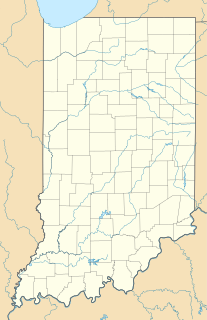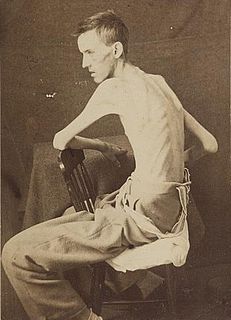Related Research Articles

Posey County is a county located in the southwestern corner of the U.S. state of Indiana. Its southern border is formed by the Ohio River, and the western border by the Wabash River, a tributary. As of 2010, the population was 25,910. The county seat is Mount Vernon.

Gibson County is a county in the southwestern part of the U.S. state of Indiana. As of 2010, the population was 33,503. The county seat is Princeton.

Fort Branch is the largest town and second largest community in Gibson County, Indiana after Princeton and ahead of the county's other city, Oakland City. The population was 2,771 at the 2010 census. It is part of the Evansville, Indiana, Metropolitan Area

Princeton is a city in Patoka Township, Gibson County, Indiana, United States. The population was 8,644 at the 2010 census, and it is part of the greater Evansville, Indiana, Metropolitan Area. The city is the county seat of and the largest city in Gibson County.

Port Gibson is a city in Claiborne County, Mississippi, United States. The population was 1,567 at the 2010 census. Port Gibson is the county seat of Claiborne County, which is bordered on the west by the Mississippi River. It is the site of the Claiborne County Courthouse.
The United States District Court for the Southern District of Indiana is a federal district court in Indiana. It was created in 1928 by an act of Congress that split Indiana into two separate districts, northern and southern. The Southern District is divided into four divisions, Indianapolis, Terre Haute, Evansville, and New Albany. Appeals from the Southern District of Indiana are taken to the United States Court of Appeals for the Seventh Circuit. The court has five judges, four full-time United States magistrate judges and two part-time magistrate judges.

Lyles or Lyles Station is an unincorporated community in Patoka Township, Gibson County, Indiana. The community dates from 1849, although its early settlers first arrived in the 1830s, and it was formally named Lyles Station in 1886 to honor Joshua Lyles, a free African American who migrated with his family from Tennessee to Indiana around 1837. Lyles Station is one of Indiana's early black rural settlements and the only one remaining. The rural settlement reached its peak in the years between 1880 and 1912, when major structures in the community included the railroad depot, a post office, a lumber mill, two general stores, two churches, and a school. By the turn of the twentieth century, Lyles Station had fifty-five homes, with a population of more than 800 people. The farming community never fully recovered from the Great Flood of 1913, which destroyed much of the town. Most of its residents left for economic reasons, seeking opportunities for higher paying jobs and additional education in larger cities. By 1997 approximately fifteen families remained at Lyles Station, nearly all of them descended from the original settlers.

Montgomery Township is the largest of the ten townships in Gibson County, Indiana as well as one of the largest townships by area in Southwestern Indiana. As of the 2010 census, its population was 3,996 and it contained 1,645 housing units, 75% of which live in areas adjacent to Owensville. Montgomery Township is served by the South Gibson School Corporation. Gibson Generating Station and Gibson Lake are located at the northern end of Montgomery Township.

Southwestern Indiana is an 11-county region of southern Indiana, United States located at the southernmost and westernmost part of the state. As of the 2010 census, the region's combined population is 474,251. Evansville, Indiana's third-largest city, is the primary hub for the region, as well as the primary regional hub for a tri-state area which includes Kentucky and Illinois. Other regional hubs include Jasper, Vincennes, and Washington.

Giro is an unincorporated community located at the northernmost point of Gibson County in Washington Township, Gibson County, Indiana. The town is also known as Buena Vista.

King is an unincorporated community in Patoka Township, Gibson County, Indiana, United States. It is also referred to as Kings or as King's Station.

Saint James is a small hamlet located roughly 1 mile south of Haubstadt, Indiana in Johnson Township, Gibson County, Indiana and 1/4 mile north of Vanderburgh County.

Warrenton is an unincorporated community in Johnson Township, Gibson County, Indiana. Warrenton is home to The Log Inn, the oldest restaurant in Indiana.

Wheeling is an unincorporated community in Washington Township, Gibson County, Indiana, United States. The community contains a historic covered bridge over the Patoka River, the Wheeling Bridge, completed in 1877.
The Gibson County Fairgrounds are located along Embree Street across from Lafayette Park and across an intersection from Princeton Community High School in Princeton, Indiana.

This is a list of the National Register of Historic Places listings in Gibson County, Indiana.
The 10th Regiment Indiana Cavalry, also designated the 125th Indiana Regiment, was a Cavalry Regiment raised in southern Indiana to fight in the American Civil War.

The 65th Regiment Indiana Infantry, was organized in Princeton and recruited throughout the southern Indiana counties to fight in the American Civil War.
Dongola is an unincorporated community in Gibson County, Indiana, in the United States.
Mounts is an unincorporated community in Gibson County, Indiana, in the United States.
References
- ↑ Stormont, Gil R. (1914). History of Gibson County, Indiana: Her People, Industries and Institutions, with Biographical Sketches of Representative Citizens and Genealogical Records of Many of the Old Families. B.F.Bowen. p. 376.
- ↑ "Gibson County". Jim Forte Postal History. Retrieved 11 September 2014.
| This Gibson County, Indiana location article is a stub. You can help Wikipedia by expanding it. |
